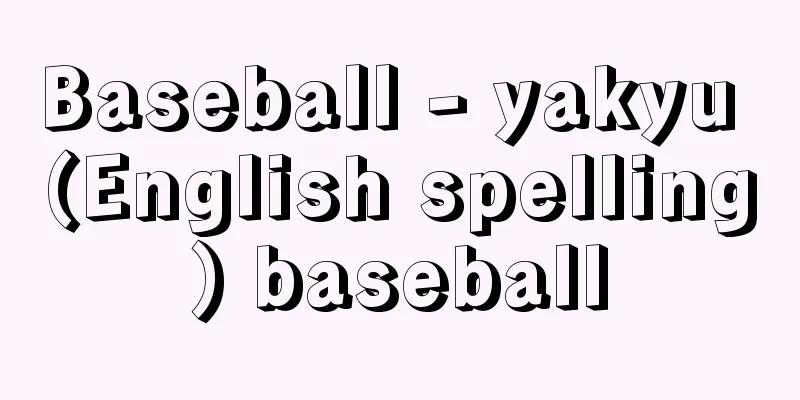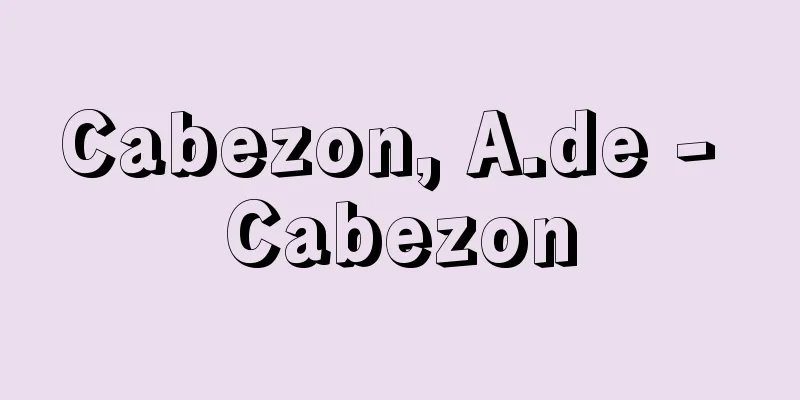Baseball - yakyu (English spelling) baseball

|
It is a team sport and a ball game. Baseball originated in America. It is played mainly in America and Japan, but also in Central America, East Asia, and Australia, and in recent years the number of players is also increasing in Europe and Africa. The game is characterized by two teams of nine players each, who alternate between offense and defense. First, the offensive batter hits the ball thrown by the defensive pitcher with a bat, and scores a point when he goes to first base, second base, third base, and home plate in that order. The attack ends when there are three outs. The first and second batting teams take turns attacking nine times each, and the game is a competition to see who can score the most points. There are various theories about its origin, but the foundations of its current form were established in America in 1845, and it became one of America's most popular sports and a national pastime, with the first professional team formed in 1869. It was introduced to Japan in 1872 (Meiji 5), and as university baseball became popular it became a popular sport nationwide, becoming by far the most popular and widespread of all sports. Globally, baseball is not widely distributed, and the number of players is not that large. Outside of the United States and Japan, professional leagues have existed in Taiwan, South Korea, and Australia since the 1980s, and it is one of the most popular sports. In Central America, Cuba, the Dominican Republic, and Puerto Rico are known as strong nations. Although baseball is not very popular in Europe, amateur leagues were established in each country in the second half of the 20th century, and the sport has been growing in popularity since the end of the 20th century. In South Asia and Africa, baseball is still in its infancy, but baseball-advanced countries are continuously promoting the sport. [Tetsushi Awamura December 11, 2020] historyAmericaThe origins of baseball are unclear, but it is thought to have developed from cricket and rounders, which originated in England. Hitting a thrown ball with a wooden stick and alternating between offense and defense are similar to cricket, while running around the bases to score points is similar to rounders. In cricket, the player who holds the bat and hits the ball is called a batsman, and this is evidenced by the fact that vestiges of this name can still be seen in baseball terminology. Rounders is said to have been brought to America in the mid-19th century and spread throughout the country during the Civil War. At the time, Rounders was an idyllic game with no set number of participants or fixed base locations, but it became popular as a form of recreation during political gatherings called "town meetings" held all over the United States, and came to be called town ball. It is a general term for games named after each town, such as Philadelphia ball or New York ball. Around this time, the characteristic of scoring by running around the four bases was born, but the rules varied and there were many crucial differences from the current rules, such as throwing the ball to get runners out. In 1845, Alexander Cartwright (1820-1892), a businessman from New York, standardized the rules of town ball and invented the prototype of baseball. He formed a team called the "Knickerbockers", recruited opponents, and actually played games. The first opponent in an external game was the "New York Nine", and it is generally believed that this was the beginning of modern baseball. The rules of this prototype, known in particular as the "Knickerbocker Rules", were the foundations of the current rules, including 42 paces (90 feet, about 27 meters) between bases, nine players per team, foul lines, a change of offense and defense after three outs, and throwing the ball to the base instead of throwing it to get runners out. For a time, the theory that "Baseball was invented by General Abner Doubleday (1819-1893) in Cooperstown, New York in 1839" was widely circulated, and the Baseball Hall of Fame Museum was built in Cooperstown as a result. However, there is no evidence that General Doubleday was involved in baseball during his lifetime, and this theory is now considered to be incorrect. Baseball quickly became a popular sport, and amateur clubs were formed and games were played all over the country, with the first amateur organization, the National Association of Baseball Players (NABBP), being founded in 1858. As the popularity of the sport grew, some players secretly began to play for pay, and in 1866 the first professional players with formal financial contracts appeared. In 1869, the all-professional Cincinnati Red Stockings were formed, causing a split with amateurists who did not like professional baseball teams that were tied to money. The first professional organization, the National Association, was launched in 1871, but it collapsed and was dissolved after five years. In 1876, the National League was formed, which was the beginning of the major leagues that continue to this day. Several other professional leagues were formed after that, but they were all short-lived, and in 1901, the two-major league system was established with the American League, which declared itself a major league, and the National League, the oldest, which continues to this day. The numerous minor leagues that existed in the United States were then integrated into the National Association, and developed into Minor League Baseball, an affiliate organization that supplied players to the major leagues. Until 1960, Major League Baseball was operated with a total of 16 teams, 8 National teams and 8 American teams, but in 1961, 2 new teams joined the American League, making it 18 teams, and in 1962, 2 new teams joined the National League, making it 20 teams. The league has expanded several times since then, and in 1998, it became a 30-team system, which remains the same today. [Tetsushi Awamura December 11, 2020] JapanThe generally accepted theory is that baseball was introduced to Japan in 1872 by Horace Wilson (1843-1927), an American who was appointed as a teacher at the First University District First Middle School, the predecessor to the current University of Tokyo, where he taught it to students. However, there are several theories that there were Americans who introduced baseball to Japan before that. In any case, there is no doubt that it began when Americans who came to Japan as employed foreigners taught the game to students and made them enjoy it. This led to the game spreading across the country as a student sport, and it became exceptionally popular both as a competitive sport and as a spectator sport. In addition, after returning from studying in the United States, Hiraoka Hiroshi (1856-1934) lived in Ministry of Public Works official housing in Shinbashi and formed the Shinbashi Athletic Club with his friends in 1878. This is known as Japan's first club team, and the game played between the team and the Komaba Agricultural College baseball team in 1882 is considered to be the first inter-club match in Japan. The First University District First Junior High School was later renamed First High School, and the First High School baseball team boasted unrivaled strength. After that, baseball teams at other universities also grew stronger, and in 1903 (Meiji 36), the first "Waseda-Keio game" (a match between Waseda University and Keio University) was held and became a big topic of conversation, and in 1905, the Waseda University baseball team went on what is said to be Japan's first tour of America, returning home with the latest knowledge, and the sport continued to develop. Furthermore, under the guidance of university students, baseball began to be played actively in secondary schools as well. The National Secondary School Baseball Championship, held at Toyonaka Ground in Osaka in 1915 (Taisho 4), was later moved to Hanshin Koshien Stadium and became the origin of the popularity of high school baseball that continues to this day. Also, seeing that after graduating, student baseball players were only active sporadically with club teams around the country, Hashido Makoto (1879-1936) of the Tokyo Nichi Nichi Shimbun came up with the idea of an Intercity Baseball Tournament. The first tournament was held at Meiji Jingu Baseball Stadium in 1927 (Showa 2), and it is still regarded as the highest level tournament for amateur baseball today. As student baseball continued to develop, professional baseball also began in 1936 with the founding of Japan's first professional league, the Japan Professional Baseball Association (renamed the Japan Baseball Association in 1939). At first, there was a strong tendency to dislike playing baseball for money, but it gradually gained popularity. Due to the intensification of the Pacific War, league matches were temporarily suspended at the end of the 1944 season, but after its revival in 1946 (Showa 21) after the war, professional baseball's popularity increased even more. At the end of 1949, professional baseball split into two leagues, the Central League and the Pacific League, which were formed. At the same time, the Japan Baseball Association was dissolved and the Nippon Professional Baseball Organization (NPB) was established. In 1950, the first year of operation, there were eight teams in the Central League and seven in the Pacific League, but there were mergers and abolitions, and by 1958, each league had six teams, which is the current number. Since the beginning of the 21st century, the rise of independent leagues and the increase in the number of female baseball players have been major changes. Independent leagues, such as the Shikoku Island League, which was established in 2005, and the Hokushinetsu BC (Baseball Challenge) League, which was established in 2007, have become a place for young people aiming to play in the NPB, and the number of players moving on to the NPB is increasing. Women's baseball was held by professional teams immediately after the war, but it went into decline within about 10 years. From around 2000, amateur baseball became popular again, and the number of players is increasing. In the Women's Baseball World Cup, they won six consecutive championships from the 3rd tournament in 2008 to the 8th tournament in 2018, and a women's professional baseball league was launched in 2010, and has gained a certain level of popularity. [Tetsushi Awamura December 11, 2020] SoftballRubber ball baseball is a sport unique to Japan, played using a hollow rubber "rubber ball." As baseball became more popular during the Meiji and Taisho periods, children began to play with tennis balls and sponge balls. However, these balls were inferior to the original balls (hard balls) in terms of competitiveness, so Itoi Asajiro and Suzuka Sakae (1888-1957) of Kyoto devised a rubber ball suitable for growing children, and in 1919 a company in Kobe completed it. This led to an increase in the number of young players playing baseball, and it became widely known as "rubber baseball." It also became popular as a form of recreation for adults as well as children, and the number of players increased significantly. Baseball played for fun using a rubber ball is commonly known as "kasayaku" (softball), and is recognized as a hobby for all ages. [Tetsushi Awamura December 11, 2020] International competitionsIn the 20th century, the major international baseball tournaments were the World Cup and Intercontinental Cup organized by the International Baseball Federation (IBAF), and the baseball tournament held at the Summer Olympics. The IBAF World Cup was held a total of 39 times from 1938 to 2011, and the IBAF Intercontinental Cup was held a total of 17 times from 1973 to 2010. After being held a total of seven times as an exhibition event at the Summer Olympics since 1904, baseball became an official event at the Barcelona Olympics in 1992, and was held at five consecutive Olympics. However, it was removed from the official events at the London Olympics in 2012, and has not been held since. It was added as an additional event proposed by the host city at the Tokyo Olympics scheduled to be held in 2020, but there are no plans to hold it at subsequent Olympics. These international tournaments were initially positioned as the pinnacle of amateur baseball, and professional players were not allowed to participate. Professional players were allowed to participate from the 2000 Sydney Olympics onwards, but main players from Major League Baseball did not participate. In this situation, Major League Baseball and the Major League Baseball Players Association launched a tournament called the World Baseball Classic (WBC) in 2006 as part of a strategy to popularize baseball around the world. This tournament is billed as the "best baseball tournament in the world," and is characterized by the participation of top players from Major League Baseball and Nippon Professional Baseball. Since the second WBC tournament was held in 2009, it has been held every four years. The IBAF, which felt a sense of crisis over baseball's exclusion from the Olympics, cooperated with the International Softball Federation (ISF) to establish the World Baseball Softball Confederation (WBSC) in 2013 to oversee both organizations, abolishing the traditional World Cup and Intercontinental Cup and making the WBC an official tournament. Furthermore, the WBSC established age-group World Cups for U-23, U-18, U-15, and U-12, as well as a Women's World Cup, and in 2015 created a tournament called the "WBSC Premier 12," in which the top 12 countries in the world baseball rankings determined by the WBSC compete for the world championship in the years between the WBC events. [Tetsushi Awamura December 11, 2020] Competition MethodIn a fenced arena, players are divided into two teams of nine players each led by a manager, and proceed under the authority of one or several umpires. A starting player can be replaced by a substitute player at any time when the ball is dead, but once a player has retired, he or she cannot play again. A game begins when one team is on the defensive, the umpire calls "play," and the pitcher throws the ball to the batter on the offensive team. The defensive players are divided into nine positions: (1) pitcher, (2) catcher, (3) first baseman, (4) second baseman, (5) third baseman, (6) shortstop, (7) left fielder, (8) center fielder, and (9) right fielder. When playing defense, players may take any position on fair ground, but they must notify the umpire if they wish to permanently switch from their previously registered defensive position to another position. The batter can choose whether to hit the pitcher's pitch or not. If the batter hits the pitch, he advances to first base, second base, and third base, and when he returns to home base (home base or home plate), one point is scored. The team with the most points wins, so the offensive team tries to score as many points as possible, and the defensive team tries to concede as few points as possible. The batting order of the offensive team is decided in advance, and nine players take turns batting. There is also a system of using a designated hitter to bat in place of the pitcher when it is his turn to bat. There are penalties for mistakes in the batting order, but if no one notices and points out the mistake, the game will continue as it is. If a batter lets the pitch go unpunished, the umpire will decide whether the pitch is a strike or a ball. A strike is one that passes through the strike zone set above home plate, and if a pitch that the batter does not hit passes through the strike zone, even a part of it, it is called a strike. If it does not pass through the strike zone, it is called a ball. A batter who tries to hit the ball but misses also counts as a strike. If a strike is called three times, the batter is out (strikeout), and if a ball is called four times, the batter is awarded a base on first base (a walk). In principle, if the pitch hits the batter outside the strike zone, the batter can still go to first base (a dead ball). The playing field is divided into fair territory and foul territory, and the fair territory is the area that is drawn in a sector with a central angle of 90 degrees from home plate. Fair territory and foul territory are separated by foul lines. Outside of the fair territory is foul territory. If the ball hit by the batter flies into fair territory, play continues, but if it flies into foul territory, play is stopped and the ball must be hit again. The standard for determining whether a batted ball is fair or foul is the foul line, and if a fly ball lands in fair territory, it is fair, and if it lands in foul territory, it is foul. Since the foul line is part of the fair territory, if the batted ball touches the foul line even a little, it is fair. For ground balls rolling on the ground, first base and third base are the standards, and if it passes through fair territory when passing through the bases, it is fair, and if it passes through foul territory, it is foul. When a batter hits the ball, he runs toward first base. After that, he attempts to advance to second base, third base, and home plate as long as play is still ongoing. If he cannot advance, he touches the base and stays there. If the ball is foul, both the batter and the runner return to their original positions and try again. When a batter hits a foul and tries again, one strike is added to the batter's total. However, fouls after two strikes do not count toward the total. If a fielder catches a hit ball directly before it touches the ground, the batter is out. If the ball is a ground ball, the batter is out if the fielder tags the ball with his body before the batter reaches first base, or if the fielder holds the ball and touches first base. When tagging the ball, the ball can touch the runner's body directly or with the glove holding the ball. If the ball is tagged to the body of a runner who is not touching a base, the runner is called out. This is called a "tag out." Also, if a runner is forced out by the batter becoming a runner and is obligated to advance, the runner can be called out by simply touching the ball or the body of a fielder holding the ball to the base before the runner reaches the base. A runner in this state is called a "force out," and such an out is called a "force out." In this way, the pitcher faces the batter one by one, and the game progresses depending on the batting results. When the defense gets three outs, the offense ends and the offense and defense switch. An inning ends when the first and second batting teams have each completed their attacks. The time when the first batting team is batting is called the "top" and the time when the second batting team is batting is called the "bottom". A formal game is decided after nine innings. If the second batting team is leading, the bottom of the ninth inning is not played and the game ends. Also, if the second batting team scores a winning run in the bottom of the ninth inning with the score tied, the game is called off at that point (goodbye game). If a formal game is called off for any reason before completing the 9 innings, and at least 5 innings have been completed and the winner has been decided by the score difference, the game will be considered a formal game as a called game. If the winner has not been decided, the game will be considered a suspended game and continued at a later date. If the conditions for a formal game are not met, the game will be considered a no-game and will be invalidated. If both teams are still tied after nine innings, the game continues until a winner is decided. The game ends if the team batting first is ahead at the end of the first and second innings, or if the team batting second scores the winning run during the bottom of the extra innings. However, the original rules state that the game should continue until a winner is decided, but outside of American professional baseball, it is often difficult to implement unlimited extra innings, and many leagues and tournaments have rules for draws and rematches. In the 21st century, the "extra innings tiebreaker method," which makes it easier to decide the winner by starting an inning with runners on base, has been widely adopted in amateur baseball. If either team has fewer than nine players or disobeys the umpire's instructions regarding the game progress, the game is forfeited and the team in violation loses 9-0. If the umpire's decision is in violation of the rules and the manager requests a review, the game is a protest game and the league president's decision is sought. However, even if it is concluded that the umpire's decision was in violation of the rules, a replay of the game will not be ordered unless it is determined that the team in violation lost the opportunity to win. When pitching to a batter, a pitcher must adopt either a "windup position" or a "set position". In both pitching positions, the pitcher must have his pivot foot touching the pitcher's plate. In the windup position, the pitcher is free to place his non-pivot foot anywhere, and before pitching, he must either raise both hands over his head or lightly place them in front of his body before throwing. In the set position, the pitcher must place his non-pivot foot in front of the pitcher's plate and be completely still, holding the ball in front of his body with both hands before pitching. The set position allows the pitcher to make the pitching motion more quickly, so it is often used when there are runners on base. Pitchers try to prevent the batter from hitting the ball or the runner from advancing to the next base, but if such actions deceive the batter or runner, a "balk" is called, and the runner is awarded one base. There are 13 rules for balks, but the most common are pitching without remaining still in the set position and not taking the correct step when throwing to a base. In addition, two illegal pitches are prohibited: (1) pitching to the batter without touching the pitcher's plate, and (2) a quick return pitch, which is a sudden pitch that takes the batter off guard. Both the batter and the pitcher need to work on speeding up, and when there are no runners on base, the pitcher must throw the ball within 12 seconds of receiving it. In addition, there are often rules in the league or federation that require the pitcher to throw the ball within 20 seconds when there are runners on base. In addition, the batter is obligated to enter the batter's box promptly and assume his batting stance when it is his batting time, and is not allowed to leave the batter's box during his batting time. Interference can be broadly divided into four types: by the offensive team, by the defensive team, by the umpire, and by spectators. If an offensive player interferes with the opposing team's defensive play, that player is generally called out and other runners are not allowed to advance. However, if the player who interfered has already been called out or if the interference was malicious and deliberate, other players may also be called out. If a defensive player interferes with the opponent's batting or base running, the batter or runner will be allowed to advance to remove the disadvantage, or the umpire will judge the situation as it would be if there was no interference and take appropriate action. The umpire may only cause interference when he or she interferes with the catcher's throwing motion or when the umpire touches the ball before it passes the fielder. In this case, the umpire may invalidate the play and have the player replay it, or may award an appropriate base advance, in order to eliminate the player's disadvantage. Spectator interference occurs when spectators enter the field, lean out of the stands, throw objects into the field, or otherwise interfere with the defense. If there is interference from spectators, the game is stopped and, at the discretion of the umpire, the offensive player is called out or an appropriate base is advanced based on the situation as if there had been no interference. The match is presided over by the umpire, who makes the appropriate decision for each play to proceed with the match. The umpire's decision cannot be challenged. Players, managers, coaches, or substitute players are not allowed to challenge the decision, and if they continue to challenge the decision despite the umpire's warning, or if they use abusive language or violence against the umpire, they will be ejected and removed from the match. However, if there is any doubt that the umpire's decision is against the rules, only the manager can request that it be changed to the correct decision. A decision made by one umpire may not be criticized, changed or challenged by the other umpires, but if the decision is appealed by the manager, the advice of the other umpires may be sought. The decision made by the umpires in consultation is final and cannot be challenged further. However, despite the above principles, since the beginning of the 21st century, systems have been introduced, primarily in professional baseball, to review umpires' decisions using video. When a video replay system is in place, managers can request video review of decisions based on umpires' judgment under certain conditions. In such cases, the decision made after review is final. The rules require at least one umpire, but usually there are multiple. The roles are divided into three types: the home plate umpire who is located behind the catcher and calls pitches as strikes or balls, the base umpire who is located near the base and calls each base, and the outside umpire who is located in the outfield and mainly calls out fly balls in the outfield. There are established systems for two umpires, one home plate umpire and one base umpire, three umpires, one home plate umpire and two base umpires, four umpires, one home plate umpire and three base umpires, and six umpires, one home plate umpire, three base umpires, and two outside umpires. [Tetsushi Awamura December 11, 2020] Sports equipmentballIt is made by wrapping thread around a small core of cork, rubber or similar material, wrapping it in two pieces of white horsehide or cowhide, and firmly stitching it together with thread. In Japan, cowhide is used. It weighs 5 to 5 1/4 ounces (141.7 to 148.8 grams) and measures 9 to 9 1/4 inches (22.9 to 23.5 centimeters). All types of baseball called "hardball" in Japan, from professional baseball to little league baseball, use the same ball specifications. Softball balls have a rubber rim and come in four sizes: M size (for adults to junior high school students), J size (for upper elementary school students), D size (for lower elementary school students), and H size (semi-hard ball), each with a different diameter, weight, and restitution coefficient. Intentionally soiling or damaging the ball is prohibited by the rules because it can cause the ball to change direction in an advantageous way for the pitcher. Violations can result in heavy penalties, such as ejection or suspension. [Tetsushi Awamura December 11, 2020] batIt is a smooth, round stick made from a single piece of wood, with a diameter of 2.61 inches (6.6 cm) or less at its thickest point and a length of 42 inches (106.7 cm) or less. In amateur baseball, metal bats and bats made of joined pieces of wood or bamboo may be permitted. Plain wood bats may also be painted, depending on the regulations of each league. A bat with the tip of the bat must be called a cup bat, and when gumming, it must be curved in a bowl-shaped shape, within a quarter of a depth of 1 inch (3.2 cm) and at least 1 inch (2.5 cm) in diameter. It is permitted to allow any substance to be attached or roughened to the grip part of the bat (18 inches (45.7 centimeters) from the edge) to make it easier to grip, but it is prohibited to use a bat that has been crafted beyond the 18-inch limit in matches. In this case, you will only be forced to replace the bat and there will be no penalty. It is not possible to use or attempt to use bats that have been modified or modified to increase the distance of the ball or create abnormal repulsion. Specific examples include stuffing, flattening the surface, hammering nails, hanging inside, grooved, or covered with paraffin, wax, etc. The base advance caused by using such a bat is not accepted, and the batter is declared out and removed from the game. [Awamura Tetsushi December 11, 2020] Gloves and mittsDefensive players can wear thick leather gloves called gloves. Catchers and first basemen can wear gloves with special shapes called mitts rather than regular gloves. Compared to regular gloves, mitts are shaped specifically for catching. There is no limit to the weight of the grab and mitt. The dimensions are defined as less than 13 inches (33.0 centimeters) from the tip to the bottom for the fielder's grab and first baseman's mitt, and less than 1/2 of the catcher's mitt (39.4 centimeters). A web is attached to the slit between the thumb and index finger of the grab and mitt. The body color of the glove or mitt can be either natural leather or colored, but it cannot be used in a light color (a color lighter than Pantone PANTONE's color standard 14). Also, there are strict color restrictions for pitcher gloves, as it illustrates the batter. Pitcher gloves must be colored other than white or gray, except for the border, and cannot be colored different from those gloves. [Awamura Tetsushi December 11, 2020] UniformEach player on the same team must wear uniforms of the same color, same shape, and design, and wear a number of at least 6 inches (15.2 centimeters). Uniforms are usually baseball caps, short sleeved tops and long pants, underwear underneath the tops, and two layers of socks. The two layers of socks are a remnant of the old gaiters, usually wearing white socks and colored stockings. The outside of the undershirt must be all players on the same team in the same color. Players wearing uniforms that are different from other players on their team cannot participate in the match. In professional baseball, the uniform design needs to be changed for home and visitors, with home use white as a base, and visitors use colored items. This is not necessary for amateur baseball. [Awamura Tetsushi December 11, 2020] Baseball StadiumFirst, decide on home plate, and measure the distance of 127 feet, 3 in. (38.795 meters) from that point to determine the position of second base. Next, measure 90 feet (27.431 meters) each with home plate and second base as the base point, and the intersection on the right side from home plate is first base, and the intersection on the left side from home plate is third base. This will also make the distance between first and third base 127 feet, 3 in. This divides the 90 feet square, with first base, second base, third base, and home plate as the top, called the infield. The baseline connecting each base on the infield and bases should be on the same plane, with a pitcher board near the center of the infield. The pitcher board must be located 10 inches (25.4 centimeters) above home plate, and a slope of 1 inch (2.5 centimeters) per foot (30.5 centimeters) from the point 6 inches (15.2 centimeters) ahead of the pitcher board to a point 6 feet (182.9 centimeters) towards home plate, and the slope must be the same for each stadium. Ideally, the line that goes from home plate to second base from the pitcher's board is headed northeast. The distance from home plate to the backstop and from the base line to the fence, stands, or facilities that interfere with play should be at least 60 feet (18.288 meters). The outfield is the area between the foul line, which extends the first and third base lines. The distance from home plate to the outfield fence, stands or facilities on the fair ground requires more than 250 feet (76.199 meters) to the fair ground outfield fence, stands or play-impeding facilities, but priority is given to both wings being 320 feet (97.534 meters or more) and mid-level players at least 400 feet (121.918 meters). In stadiums built by professional baseball teams, the minimum distance between the wings is 325 feet (99.058 meters). The boundary line is the foul line drawn from home base to first base and from home base to third base to the outfield, with the infield and outfield within which the infield and outfield are the fair ground. The boundary line is included in the fair ground. The rest of the area is the foul ground. Others include battersbox, catchersbox, next battersbox, coachesbox, and three-foot lines (officially three-foot first baseline) in the specified position. These lines, including the foul lines, should be 3 inches wide (7.6 centimeters) wide and should be painted with white materials such as paint or non-flammable chalk. It is common to lay grass in the outfield, but it is not specified by regulations. The presence or absence of grass and shape can be determined at any stadium. In the world, including the United States, the birthplace of baseball, many of the inside and outfield areas cover all parts of the base line with grass. In Japan, the majority of the turf is soil and the outfield is grass. In addition, artificial turf is sometimes used, and in this case only the area around the bases is soil. Home plate is displayed on a white pentagonal rubber plate. This pentagon is made as follows: First, draw a square with one side of 17 inches (43.2 centimeters) and decide on one side of 17 inches, and each side adjacent to it is 8 inches (21.6 centimeters). Then, create two sides of 12 inches (30.5 centimeters) from each point. Place the two 12 inches (30.5 centimeters) of each side at the base point of home plate, with the 17 inches facing the pitcher's board, and the two 12 inches coincide with the first and third base line. Place the surface of home plate horizontally with the ground. The bases of first base, second base and third base should be displayed as white canvas or rubber-covered bags. The bags should be packed with soft material and should be 15 inches (38.1 cm) square, and 3 inches (7.6 cm) to 5 inches (12.7 cm). The bags on first and third base should be fully inside the infield. To do this, place them closely over the foul line, and the corners far from home plate should match the base point of first and third base. The bags on second base should be centered in line with the base point of second base. The pitcher's board will be made of a rectangular white rubber plate 24 inches (61.0 centimeters) wide and 6 inches (15.2 centimeters) long. The distance from the center of the leading edge of the pitcher's board to the tip of the pentagon at home plate is 60 feet 6 inches (18.44 meters). Benches for players to stand in are set at a minimum of 25 feet (7.62 meters) from each base line. Enclosures must be set up at the left and right rear of the bench and a roof must be provided. In large baseball fields where auditor stands are installed, benches are often made in-depth into the structure, and such shapes are called dugouts. In professional baseball, other requirements include placing cushioning material on fixed fences to prevent danger, installing a back screen (a background board to prevent batters from seeing pitchers) in the middle-sized position, installing a scoreboard to display scores and batting order, installing a bullpen for pitching practice, and the height of the foul pole must be at least 16 meters tall. The biggest feature of baseball stadiums is that the outside world is that the size and shape of the outfield and foul ground are quite variable. In major league stadiums, many of them are known for their unique construction, such as asymmetrical shapes on the left and right sides of the outfield, and huge fences to compensate for the short distance. In Japan, there are no baseball fields with a very unique shape, but the size of the outfield and foul ground differs depending on the stadium. [Awamura Tetsushi December 11, 2020] になったんです。 English: The first thing you can do is to find the best one to do . [Reference items] | | | | | | |Source: Shogakukan Encyclopedia Nipponica About Encyclopedia Nipponica Information | Legend |
|
団体運動競技で、球技の一つ。アメリカ発祥のベースボールbaseballの訳。アメリカ、日本を中心に、中米、東アジア、オーストラリアで盛んに行われ、近年ではヨーロッパ、アフリカでも競技人口が拡大している。1チーム9人ずつの2チームに分かれ、攻撃と守備を交互に繰り返すのが特徴。まず、守備側の投手が投げた球を、攻撃側の打者がバットで打ち、一塁、二塁、三塁、本塁の順に回ると得点となる。攻撃はアウト三つで終了する。先攻チームと後攻チームが交互に9回ずつ攻撃をして、その得点の多さを競うゲームである。 起源については諸説あるが、1845年にアメリカで現在の形の基礎がつくられ、1869年には最初のプロチームが生まれるなどアメリカ有数の人気スポーツとなり、国民的娯楽となった。日本には1872年(明治5)に伝えられ、大学野球が盛んになったところから全国的な人気スポーツとなり、多くのスポーツのなかでも群を抜いて親しまれ、普及した。 世界的には普及に偏りがあり、競技人口もそれほど多くない。アメリカ、日本以外では、台湾や韓国、オーストラリアには1980年代からプロリーグがあり、人気スポーツの一つである。中米諸国ではキューバ、ドミニカ、プエルトリコなどが強豪国として知られている。ヨーロッパではあまり盛んではないものの、20世紀後半には各国でアマチュア連盟が創設されており、20世紀末ごろから人気の高まりをみせている。南アジアやアフリカではまだ発展途上だが、野球先進国による普及活動が継続的に行われている。 [粟村哲志 2020年12月11日] 歴史アメリカ野球の起源は明確に特定されていないが、イギリス発祥のクリケットやラウンダーズが発展して成立したものと考えられている。投げられた球を木の棒で打つところや攻守交代制はクリケットに、塁を回って得点するところはラウンダーズに似ている。クリケットではバットを持って球を打つ者をバッツマンとよぶが、野球用語にもその名残(なごり)がみられることなどはその証左である。ラウンダーズは19世紀なかばにアメリカにもたらされ、南北戦争を通じて各地に広まったとされる。 当時のラウンダーズは参加人数も塁の位置も定まっていない牧歌的な遊びであったが、アメリカ各地で開かれた「タウン・ミーティング」とよばれる政治集会の際のレクリエーションとして好まれるようになり、タウン・ボールともよばれるようになる。町ごとの名前が冠されてフィラデルフィア・ボールとかニューヨーク・ボールなどとよばれた遊びの総称である。このころ四つの塁を回って得点する特徴が生まれたものの、ルールはまちまちで、走者をアウトにするためにボールを投げ当てるなど、現在のルールと決定的に違う点も数多くあった。 1845年、ニューヨークの実業家アレキサンダー・カートライトAlexander Cartwright(1820―1892)が、このタウン・ボールのルールを統一してベースボールの原型を考案し、自ら「ニッカーボッカーズ」というチームを結成して対戦相手を募り、実際に試合も行った。初めての対外試合の相手は「ニューヨーク・ナイン」であり、このことをもって近代野球の創始とする説が一般的である。この原型のルールをとくに「ニッカーボッカー・ルール」とよび、塁間が42ペイス(90フィート、約27メートル)、1チーム9人、ファウル・ラインの設定、アウト三つで攻守交代、走者をアウトにするためにボールを投げ当てるのではなく塁にボールを送ることとするなど、現在のルールの基礎がつくられた。 なお、ある時期まで「ベースボールは1839年にニューヨーク州のクーパーズタウンで、将軍アブナー・ダブルデイAbner Doubleday(1819―1893)によって考案された」という説が流布しており、そのためクーパーズタウンには野球殿堂博物館も建設されて広く知られている。しかし、ダブルデイ将軍が生前ベースボールにかかわっていた形跡はなく、現在では誤りとされている。 ベースボールはたちまち人気スポーツとなり、アマチュアクラブが盛んにつくられて各地で試合が行われ、1858年には初のアマチュア組織NABBP(ナショナル・アソシエーション・オブ・ベースボール・プレイヤーズ)が発足した。人気が過熱するにつれ、ひそかに報酬を得てプレーする者も現れ、1866年には初めて正式に金銭契約を結ぶプロ選手が登場する。さらに1869年には全員がプロ選手の「シンシナティ・レッドストッキングス」も誕生し、金銭がらみのプロ球団を好まないアマチュア主義者との分裂を招いた。 1871年に初のプロ組織「ナショナル・アソシエーション」が発足するも運営が破綻(はたん)して5年で解散したが、1876年に「ナショナル・リーグ」が結成され、これが現在まで続くメジャー・リーグのはじめである。その後いくつかのプロリーグがおこるがいずれも短命に終わり、1901年にメジャー・リーグ宣言をした「アメリカン・リーグ」と最古参のナショナル・リーグとの二大リーグ制が確立されて現在に至っている。そしてアメリカ国内に数多く存在したマイナーリーグは「ナショナル・アソシエーション」として統合され、メジャー・リーグに選手を供給する傘下組織としての「マイナー・リーグ・ベースボール」へと発展した。 メジャー・リーグは1960年までナショナル8球団、アメリカン8球団の計16球団で運営されたが、1961年にアメリカン・リーグに2球団が新加入し18球団、1962年にナショナル・リーグに2球団が新加入し20球団となる。その後も何度かリーグの拡張が実施され、1998年に30球団制となって現在に至る。 [粟村哲志 2020年12月11日] 日本日本に野球が伝わったのは、1872年に現在の東京大学の前身である第一大学区第一番中学に教師として赴任したアメリカ人のホーレス・ウィルソンHorace Wilson(1843―1927)が生徒たちに教えたことによるものであるというのが定説である。ただし、それ以前にも野球を伝えたアメリカ人がいたという説がいくつかある。いずれにしてもお雇い外国人として来日したアメリカ人が学生たちに伝え、楽しまれたのが始まりであることは間違いない。これによって学生スポーツとして全国に広まり、競技スポーツとしても観戦スポーツとしても別格の人気を博した。 また、アメリカ留学から帰国した平岡煕(ひらおかひろし)(1856―1934)が新橋の工部省官舎に住み、1878年に仲間と結成した「新橋アスレチック倶楽部(くらぶ)」は日本初のクラブチームとして知られており、1882年に駒場農学校野球部との間に行われた試合が、日本初の対抗試合とされる。 第一大学区第一番中学はのちに第一高等学校と改称され、一高野球部は無類の強さを誇った。その後、他大学の野球部も力をつけ、1903年(明治36)に初めて「早慶戦」(早稲田(わせだ)大学と慶応義塾大学の対抗戦)が行われて大きな話題となったり、1905年に早大野球部が日本初とされるアメリカ遠征で最新知識を得て帰国したりと、発展の一途をたどった。 さらに大学生の指導のもとで中等学校でも野球が盛んに行われるようになり、1915年(大正4)に大阪の豊中グラウンドで行われた全国中等学校優勝野球大会は、のちに阪神甲子園球場に会場を移し、現在まで続く高校野球人気の原点となった。 また、学生野球の選手が卒業したのちは各地のクラブチームで散発的に活動するのみだった状況をみた東京日日新聞の橋戸信(はしどまこと)(1879―1936)が「都市対抗野球大会」を発案。1927年(昭和2)に明治神宮野球場で第1回大会を開催し、現在でも社会人野球最高峰の大会と位置づけられている。 学生野球中心の発展が続くなか、1936年には日本初のプロリーグ「日本職業野球連盟」(1939年に「日本野球連盟」と改称)が設立され、プロ野球も始まった。当初は金銭を得て野球をすることを嫌う風潮も強かったが、しだいに人気を博した。太平洋戦争の激化により1944年シーズンをもってリーグ戦は一時休止され、戦後の1946年(昭和21)に復活してからプロ野球人気はさらに高まった。プロ野球は1949年末2リーグに分裂し、「セントラル・リーグ」と「パシフィック・リーグ」が発足した。同時に日本野球連盟も解散し、日本野球機構(NPB)が設立された。運営初年度の1950年はセ・リーグ8球団、パ・リーグ7球団だったが統廃合があり、1958年には両リーグ6球団ずつとなって現在に至っている。 21世紀に入ってからは、独立リーグの隆盛と女子野球人口の拡大が大きな変化である。2005年(平成17)に発足した「四国アイランドリーグ」と2007年に発足した「北信越BC(ベースボール・チャレンジ)リーグ」を中心とした独立リーグがNPBを目ざす若者たちの受け皿となり、NPBに進むプレーヤーも増加している。女子野球は戦後すぐにプロ球団が興行を行ったものの10年ほどで下火になり、2000年ごろからふたたびアマチュア野球で盛んとなって競技人口も増加している。女子野球ワールドカップでは2008年の第3回大会から2018年の第8回大会まで6連覇を達成し、2010年には女子プロ野球リーグも始まって一定の人気を博している。 [粟村哲志 2020年12月11日] 軟式野球軟式野球は、ゴム製で中空の「軟式ボール」を使用して行われる、日本独自の競技である。 明治、大正期の野球人気の高まりとともに、子どもたちはテニスボールやスポンジ製のボールを用いて野球遊びをするようになった。しかし、これらのボールは競技性の点で本来のボール(硬式球)に劣ったため、京都の糸井浅次郎と鈴鹿栄(すずかさかえ)(1888―1957)が、成長期の子どもに適したゴム製のボールを考案し、1919年に神戸市の会社が完成させた。これによって少年野球人口が増加し、軟式野球とよばれて広く普及した。また、子どもたちだけでなく大人のレクリエーションとしても広く人気を博し、競技人口が大きく拡大した。軟式球を用いて行う楽しみのための野球は俗に「草野球」とも称され、全年代的な趣味として認知されている。 [粟村哲志 2020年12月11日] 国際大会20世紀においては、国際野球連盟(IBAF)主催の「ワールドカップ」および「インターコンチネンタル・カップ」と、夏季オリンピック大会で実施される野球競技が主要な国際大会だった。IBAFワールドカップは1938年から2011年まで計39回実施され、IBAFインターコンチネンタル・カップは1973年から2010年まで計17回実施された。夏季オリンピックでは1904年以降、公開競技として計7回行われた後、1992年のバルセロナオリンピックで正式競技となり、5大会連続で実施された。しかし2012年のロンドンオリンピックで正式競技から除外されて実施されなくなった。2020年に開催予定であった東京オリンピックで開催都市提案の追加競技となったが、その後の大会で実施される予定はない。 これらの国際大会は当初、アマチュア野球の最高峰として位置づけられ、プロ選手は参加しなかった。2000年のシドニーオリンピックからプロ選手の参加も認められたが、メジャー・リーグの主力選手は参加しなかった。 このような状況のなかで、メジャー・リーグ機構とメジャー・リーグ選手会が、世界に野球を普及させる戦略の一環として、2006年に「ワールド・ベースボール・クラシック(WBC)」という大会を立ち上げた。この大会は「野球の世界一決定戦」と銘打たれ、メジャー・リーグや日本プロ野球からもトップ選手が参加していることが特徴である。WBCは第2回大会を2009年に実施した後、4年に一度ずつ開催されている。 野球のオリンピック除外に危機感を募らせたIBAFは、国際ソフトボール連盟(ISF)と協力して、両組織を統括する世界野球ソフトボール連盟(WBSC)を2013年に設立し、従来のワールドカップやインターコンチネンタル・カップを廃止してWBCを公認大会とした。さらにWBSCはU-23、U-18、U-15、U-12の年代別ワールドカップおよび女子ワールドカップを整備するとともに、2015年には「WBSCプレミア12」という大会を創設し、WBCが開催される中間の年に、WBSCが定める世界野球ランキング上位の12か国が世界一を競うこととした。 [粟村哲志 2020年12月11日] 競技方法囲いがある競技場で、監督が指揮する9人のプレーヤーからなる二つのチームに分かれて、1人ないし数人の審判員の権限で進行する。先発プレーヤーが控えプレーヤーと交代することはボールデッドのときならいつでも可能だが、一度退くとふたたびプレーすることはできない。 試合は片方のチームが守備につき、審判員が「プレー」の宣告をし、投手(ピッチャー)が攻撃側の打者(バッター)に投球して始まる。守備側のプレーヤーは(1)投手、(2)捕手(キャッチャー)、(3)一塁手(ファースト・ベースマン)、(4)二塁手(セカンド・ベースマン)、(5)三塁手(サード・ベースマン)、(6)遊撃手(ショート・ストップ)、(7)左翼手(レフト・フィールダー)、(8)中堅手(センター・フィールダー)、(9)右翼手(ライト・フィールダー)の九つのポジションに分かれて守る。守備の際はフェア・グラウンドであればどこに位置しても差し支えないが、あらかじめ届け出た守備位置から他のポジションへ恒常的に入れ替わる際は審判員に申し出る必要がある。 投手の投球を打つか打たないかは打者が選択できる。打者は投球を打ったら一塁(ファースト・ベース)、二塁(セカンド・ベース)、三塁(サード・ベース)と進み、本塁(ホーム・ベースまたはホーム・プレート)に戻ると1点が記録される。得点の多いほうが勝ちとなるので、攻撃側はより多くの得点をあげるよう努め、守備側は失点を少なくするように努める。 攻撃側の打者が打つ順番はあらかじめ決められており、9人が順番に打つことを繰り返す。投手が打つ番のときにかわりに打つ指名打者を用いる制度もある。打順の間違いには罰則があるが、だれも気づかず指摘されなければ試合はそのまま進む。 打者が投球を見送った場合、審判員はその投球がストライクかボールかを判定する。ストライクとは本塁上に設定されたストライク・ゾーンを通過したものをいい、打者が打たなかった投球が、ボールの一部分でもストライク・ゾーンを通過すればストライクと判定される。ストライク・ゾーンを通過しなければボールとなる。打者が打とうとして空振りしたものもストライクに数えられる。ストライクを3回宣告されると打者はアウト(三振)になり、ボールが4回宣告されると打者に一塁への出塁が与えられる(フォア・ボール、四球)。投球がストライク・ゾーン以外で打者の身体に当たった場合も、原則として一塁へ行ける(デッド・ボール、死球)。 競技場はフェア地域とファウル地域に区分されており、本塁を基点として中心角90度の扇形を描いた部分がフェア地域である。フェア地域とファウル地域はファウル・ラインによって区切られる。フェア地域の外側がファウル地域となる。打者の打った打球がフェア地域に飛べばプレーが続けられ、ファウル地域に飛べばプレーは停止されて打ち直しとなる。打球がフェアかファウルかを判断する基準はファウル・ラインであり、飛球がフェア地域に落ちればフェア、ファウル地域に落ちればファウルとなる。ファウル・ラインはフェア地域の一部であるため、打球がファウル・ラインに少しでもかかっていればフェアとなる。地面を転がるゴロの打球については一塁ベース、三塁ベースが基準となり、ベースを通過する際にフェア地域を通ればフェア、ファウル地域を通ればファウルとなる。 打者は投球を打ち返したら一塁に向かって走る。その後、プレーが継続されている限り二塁、三塁、本塁と進むよう努める。進めなければ塁に触れてとどまる。打球がファウルとなれば打者も走者も元の位置に戻ってやり直す。ファウルで打ち直しの際は、打者にストライクが一つ加算される。ただし、ツー・ストライク以降のファウルはストライクに加算しない。 打ち返された打球を、地面に触れる前に野手が直接捕球すれば、その打者はアウトになる。打球がゴロの場合は、打者が一塁に到達する前に打者の身体にボールをタッグするか、ボールを保持して一塁ベースに触れれば打者はアウトになる。ボールをタッグする際は、ボールを直接走者の身体に触れさせてもよいし、ボールを保持したグラブを触れさせてもよい。 塁に触れていない走者の身体にボールをタッグすれば、その走者はアウトになる。これを「タッグ・アウト」とよぶ。また、打者が走者となったために押し出されて進塁の義務が生じた走者に対しては、走者がその進塁先の塁に到達する前に、その塁にボールまたはボールを保持した野手の身体を触れさせるだけでアウトにすることができる。このような走者の状態を「フォースの状態」といい、このようなアウトを「フォース・アウト(封殺)」とよぶ。 このようにして投手が打者と1人ずつ対戦し、その打撃結果によって試合が進行する。そして守備側が三つのアウトを得ると攻撃は終了し、攻守を交代する。先攻チームと後攻チームがそれぞれ攻撃を完了すると1イニング(1回)終了となる。先攻チームが攻撃する時間を「表」、後攻チームが攻撃する時間を「裏」とよぶ。正式な試合は9イニングをもって決する。後攻チームがリードを奪っている場合には9回裏は実施せず、試合を終了する。また、同点で迎えた9回裏に後攻チームが勝ち越し点をあげれば、その時点で試合は打ち切られる(さよならゲーム)。 正式試合がなんらかの理由で9イニングを完了せず打ち切られた場合、少なくとも5回を完了しており、得点差による勝敗が決していれば、コールド・ゲームとして正式試合となる。勝敗が決していない場合はサスペンデッド・ゲーム(一時停止試合)として後日継続試合を行う。正式試合の条件を満たしていなければノー・ゲームとして試合は無効となる。 両チームが9回の攻撃を完了してなお得点が等しいときは、勝敗が決するまで回数を重ねる。延長回の表裏を終わった時点で先攻チームが勝ち越しているか、延長回の裏の攻撃中に後攻チームが決勝点をあげれば試合は終了する。ただし、本来の規則では決着がつくまで延長戦を行うこととされているが、アメリカのプロ野球以外では無制限の延長戦を実施することは困難な場合がほとんどで、引き分けや再試合の規定を設けているリーグや大会が多い。21世紀に入ってからは「延長タイブレーク方式」という、あらかじめ走者が塁にいる状態からイニングを始めることで決着をつけやすくする方式が、アマチュア野球で広く採用されている。 どちらかのチームのプレーヤーが9人そろわなくなったり、試合進行に対する審判員の指示に反したりした場合はフォーフィッテッド・ゲーム(没収試合)となり、9対0で違反チームの負けとなる。また、審判員の裁定が規則に違反していると異議を申し立て、監督が審議を請求するときはプロテスティング・ゲーム(提訴試合)としてリーグ会長の判断を仰ぐ。ただし、審判員の裁定が規則に反していたと結論づけられた場合でも、その違反のために提訴チームが勝つ機会を失ったものと判断されなければ、試合のやり直しが命ぜられることはない。 投手は打者に投球するに際して「ワインドアップ・ポジション」か「セット・ポジション」のどちらかの投球姿勢をとらなければならない。どちらの投球姿勢も軸足が投手板(ピッチャース・プレート)に触れなければならないところは共通である。ワインドアップ・ポジションの場合は軸足でないほうの足の置き場所が自由で、投球前に両手を振りかぶるか身体の前方で軽くあわせてから投げる。セット・ポジションの場合は軸足でないほうの足を投手板の前方に置くことと、投球前にボールを両手で身体の前方に保持して完全に静止するという制限がある。セット・ポジションのほうが投球動作をすばやく行えるので、塁に走者がいるときに多く用いられる。 投手は打者に打たせまいと、あるいは走者を次の塁に進ませまいとくふうするが、そうした動作が打者や走者をだますようなことになる場合は「ボーク」という反則が宣告され、走者に1個の進塁が与えられる。ボークの規定は13項目あるが、そのなかでもとくにセット・ポジションでの静止を怠って投球する違反と、塁に送球する際に正しく足を踏み出さない違反をする例が多い。また、反則投球として、(1)投手板に触れないで打者に投球すること、(2)打者の虚をついて突然投球するクイック・リターン・ピッチ、の二つが禁止されている。 打者と投手はお互いにスピードアップに努める必要があり、走者なしの場合、投手はボールを受け取ってから12秒以内に投球しなければならない。またリーグや連盟の内規で、走者ありの場合も20秒以内に投球する規則が設けられていることが多い。また、打者も自分の打撃時間には速やかにバッタースボックスに入って打撃姿勢をとる義務があり、打撃時間中みだりにバッタースボックスを出ることも許されない。 妨害は攻撃側によるもの、守備側によるもの、審判員によるもの、観衆によるものの4種類に大別される。 攻撃側が相手の守備行為を妨げた場合は、原則としてそのプレーヤーがアウトになり、他の走者の進塁も許されない。ただし、妨害したプレーヤーがすでにアウトになっている場合や、悪質な故意の妨害の場合には他のプレーヤーもアウトになる場合がある。 守備側が相手の打撃や走塁を妨げた場合は、不利益が取り除かれるよう打者や走者に進塁が与えられたり、妨害行為がなかった場合の状態を審判員が判断して適宜な処置をとる。 審判員による妨害は、捕手の送球動作を妨げる場合と、野手を通過する前の打球に触れる場合の二つに限られる。この場合はプレーヤーの不利益を取り除くよう、プレーを無効としてやり直させたり、適宜な進塁を与えたりする。 観衆による妨害は、観衆が競技場内に入り込んだり、スタンドから身を乗り出したり、競技場内に物を投げ込んだりして守備の邪魔をしたりする場合に起こる。観衆による妨害があった場合は試合が停止され、審判の判断によって攻撃側のプレーヤーをアウトにしたり、妨害行為がなかった場合の状態を想定して適宜な進塁を与えたりする。 試合は審判員によって主宰され、審判員は試合を進行するために一つ一つのプレーに対して適切な裁定を下す。審判員の判断に基づく裁定には異議を申し立てることができない。プレーヤー、監督、コーチ、または控えのプレーヤーがその裁定に異議を唱えることは許されず、審判員の警告にもかかわらず異議を続けたときや、審判員に暴言を吐いたり暴力をふるったりした場合は退場処分が下されて試合から除かれる。ただし、審判員の裁定が規則に反している疑いがある場合は、監督だけが正しい裁定に変更するよう要請することができる。 1人の審判員が下した裁定に、他の審判員が批評を加えたり、変更を求めたり、異議を唱えたりすることは許されない。しかし、その裁定に対して監督からアピールを受けた場合には、他の審判員の助言を求めることができる。審判員の協議によって下された裁定は最終のものとなるので、それ以上異議を唱えることはできない。 しかしながら、上記の原則にもかかわらず、21世紀に入ってから、プロ野球を中心に映像を利用して審判員の裁定を検証するシステムが導入されている。ビデオ・リプレイの制度がある場合には、審判員の判断に基づく裁定に対しても、一定の条件のもとで監督が映像による検証を求めることができる。この場合には検証によって下された裁定が最終のものとなる。 規則では審判員は1名以上必要とされているが、通常は複数人が配置される。役割は、捕手の後ろに位置して投球に対してストライク・ボールの裁定を下す球審、塁の近くにいて各塁での裁定を下す塁審、外野に位置しておもに外野飛球に対する裁定を下す外審の3種類に分かれる。球審1人・塁審1人の2人制審判、球審1人・塁審2人の3人制審判、球審1人・塁審3人の4人制審判、球審1人・塁審3人・外審2人の6人制審判がシステムとして確立されている。 [粟村哲志 2020年12月11日] 競技用具ボールコルク、ゴムまたはこれに類する材料の小さい芯(しん)に糸を巻きつけ、白色の馬革または牛革2片でこれを包み、糸で頑丈に縫い合わせてつくる。日本では牛革を用いると定められている。重量は5~5オンス4分の1(141.7グラム~148.8グラム)、周囲は9~9インチ4分の1(22.9~23.5センチメートル)とされている。プロ野球から少年野球まで、日本で硬式野球とよばれる種類の野球ではすべて同じ規格のボールを用いる。 軟式野球用のボールの周りはゴム製で、M号(成人~中学生向け)、J号(小学高学年向け)、D号(小学低学年向け)、H号(準硬式球)の4種類があり、直径や重量、反発係数がそれぞれ異なる。 ボールを故意に汚したり傷つけたりすると投手にとって有利な変化が起きるため、規則で禁じられている。違反すると退場処分や出場停止処分などの重いペナルティーが科せられることもある。 [粟村哲志 2020年12月11日] バット1本の木材でつくられた、なめらかな円い棒であり、太さはそのもっとも太い部分の直径が2.61インチ(6.6センチメートル)以下、長さは42インチ(106.7センチメートル)以下であることが必要である。アマチュア野球では金属製バットや木片や竹片の接合バットなどが認められる場合もある。各連盟の定めにより白木(しらき)のバットを着色することもできる。 先端をえぐったバットをカップバットとよび、えぐるときは深さ1インチ4分の1(3.2センチメートル)以内、直径1インチ(2.5センチメートル)以上2インチ(5.1センチメートル)以内で椀(わん)状にカーブさせる必要がある。 バットの握りの部分(端から18インチ〈45.7センチメートル〉)になんらかの物質を付着させたり、ざらざらにしたりして握りやすくすることは認められているが、18インチの制限を超えて細工したバットを試合に使用することは禁じられている。この場合はバットを交換させられるだけでペナルティーはない。 ボールの飛距離を伸ばしたり、異常な反発力を生じさせるように加工・改造したバットを使用したり、使用しようとすることはできない。具体的な例としては、詰め物をしたり、表面を平らにしたり、釘を打ちつけたり、中をうつろにしたり、溝をつけたり、パラフィン、ワックスなどで覆ったりしたものがあげられる。このようなバットを使用したために生じた進塁は認められないし、その打者はアウトを宣告され、試合から除かれる。 [粟村哲志 2020年12月11日] グラブとミット守備をするプレーヤーはグラブとよばれる厚い革製の手袋を着用することができる。捕手と一塁手に限って通常のグラブではなく、ミットとよばれる特殊な形をしたグラブを着用することができる。ミットは、通常のグラブに比べて捕球に特化した形状をしている。 グラブとミットの重量には制限がない。寸法は、野手用グラブと一塁手のミットでは先端から下端まで13インチ(33.0センチメートル)以下、捕手用のミットは15インチ2分の1(39.4センチメートル)以下と定められている。グラブやミットの親指と人差し指の間の叉状(さじょう)の部分には網(ウェブ)が取り付けられている。 グラブやミットの本体色は革の天然色でも着色を施したものでもよいが、薄すぎる色(パントンPANTONEの色基準14番より薄い色)を用いることはできない。また、打者を幻惑するという理由から投手用のグラブは色の制限が厳しい。投手用のグラブは縁取りを除き白色、灰色以外の色でなければならず、そのグラブと異なった色のものをつけることもできない。 [粟村哲志 2020年12月11日] ユニフォーム同一チームの各プレーヤーは、同色、同形、同意匠のユニフォームを着用し、6インチ(15.2センチメートル)以上の背番号をつけなければならない。ユニフォームは野球帽と半袖の上衣に長ズボンが一般的で、上衣の下にはアンダーシャツを着用し、ソックスは2枚重ねにする。ソックスの2枚重ねは昔のゲートルの名残であり、通常は白の長靴下を履いた上に、色物のストッキングを履く。アンダーシャツの外から見える部分は同一チームの各プレーヤー全員が同じ色でなければならない。自チームの他のプレーヤーと異なるユニフォームを着たプレーヤーは試合に参加できない。 プロ野球ではホーム用とビジター用でユニフォームの意匠を変える必要があり、ホーム用は白を基調としたもの、ビジター用は色物とする。アマチュア野球ではその必要はない。 [粟村哲志 2020年12月11日] 野球場まず本塁を決め、その地点から127フィート3インチ8分の3(38.795メートル)の距離を測って二塁の位置を決める。次に本塁と二塁を基点としてそれぞれ90フィート(27.431メートル)を測り、本塁から向かって右側の交点を一塁とし、本塁から向かって左側の交点を三塁とする。これによって一塁と三塁の間の距離も127フィート3インチ8分の3となる。このようにして区画した、一塁、二塁、三塁、本塁を頂点とする90フィート平方の正方形を内野(イン・フィールド)とよぶ。 内野の各塁と塁を結ぶ線(ベースライン)は同一平面上に設け、内野の中央付近に投手板を設ける。投手板は本塁より10インチ(25.4センチメートル)高いところに設け、投手板の前方6インチ(15.2センチメートル)の地点から本塁に向かって6フィート(182.9センチメートル)の地点まで、1フィート(30.5センチメートル)につき1インチ(2.5センチメートル)の傾斜をつけ、その傾斜は各競技場とも同一でなければならない。 本塁から投手板を経て二塁へ向かう線は、東北東に向かっていることを理想とする。 本塁からバックストップまでの距離、塁線からファウル・グラウンドにあるフェンス、スタンド、またはプレーの妨げになる施設までの距離は60フィート(18.288メートル)以上を必要とする。 外野(アウト・フィールド)は、一塁線および三塁線を延長したファウル・ラインの間の地域である。本塁から、フェア・グラウンドにある外野フェンス、スタンドまたはプレーの妨げになる施設までの距離は250フィート(76.199メートル)以上を必要とするが、両翼は320フィート(97.534メートル以上)、中堅は400フィート(121.918メートル)以上あることが優先して望まれる。プロ野球の球団が建造する競技場では、両翼の最短距離は325フィート(99.058メートル)を必要とする。 本塁から一塁、および本塁から三塁を通って外野へ向かって引かれたファウル・ライン(その延長としてのファウル・ポールを含む)を境界線とし、この中にある内野および外野をフェア・グラウンドとする。境界線はフェア・グラウンドに含まれる。その他の地域はファウル・グラウンドとなる。 その他、規定の位置にバッタースボックス、キャッチャースボックス、ネクスト・バッタースボックス、コーチスボックス、スリーフット・ライン(正式にはスリーフット・ファースト・ベースライン)を描く。ファウル・ラインを含むこれらの諸線は幅3インチ(7.6センチメートル)とし、塗料または不燃性のチョークなどの白い材料で描く。 外野には芝を敷き詰めるのが普通だが、規則で定められているものではない。芝生の有無や形状は各球場で任意に定めることができる。野球の発祥国アメリカをはじめ、世界的には内外野ともに塁線以外の部分をすべて芝で覆う形状のものが多い。日本では内野が土で外野が芝という形状が大多数である。また、人工芝が用いられることもあり、この場合は塁周辺だけが土になっていることが多い。 本塁は五角形の白色のゴム板で表示する。この五角形は次のようにつくる。まず1辺が17インチ(43.2センチメートル)の正方形を描き、17インチの一辺を決めてこれに隣り合った両辺を8インチ2分の1(21.6センチメートル)とする。そして、それぞれの点から各12インチ(30.5センチメートル)の2辺をつくる。この12インチの2辺が交わったところを本塁の基点に置き、17インチの辺が投手板に面し、二つの12インチの辺が一塁線と三塁線に一致するようにする。本塁の表面は地面と水平になるように置く。 一塁、二塁、三塁の各ベースは白色のキャンバス地またはゴムで覆われたバッグで表示する。このバッグは中に柔らかい材料を詰めてつくり、大きさは15インチ(38.1センチメートル)平方、高さは3インチ(7.6センチメートル)ないし5インチ(12.7センチメートル)とする。1塁と3塁のバッグは完全に内野の中に入るよう設置する。そのためにはファウル・ラインにぴったり重なるように置き、本塁から遠いほうの角を一塁、三塁の基準点とあわせるようにする。二塁のバッグはその中心が二塁の基準点と一致するように置く。 投手板は横24インチ(61.0センチメートル)、縦6インチ(15.2センチメートル)の長方形の白色ゴムの平板でつくる。投手板の前縁の中央から本塁の五角形の先端までの距離は60フィート6インチ(18.44メートル)とする。 プレーヤーが待機するためのベンチは、各ベース・ラインから最短25フィート(7.62メートル)の地点に設ける。ベンチの左右後方には囲いをめぐらし、屋根を設けることが必要である。客席スタンドが設けられているような大きな野球場では、ベンチが構造物の中に掘り下げ式でつくられていることが多く、このような形状のものはダッグアウトとよぶ。 プロ野球ではこのほかに、固定フェンスに危険防止のための緩衝材を張ること、中堅後方にバックスクリーン(打者から投手の投球が見えにくくならないようにするための背景板)を設置すること、得点や打順を表示するためのスコアボードを設置すること、投球練習用のブルペンを設置すること、ファウル・ポールの高さは16メートル以上を必要とすることなどが定められている。 野球の競技場の最大の特徴は、90フィート平方のダイヤモンド部分以外はかなり自由度が高く、外野やファウル・グラウンドの広さ、形状がかなりまちまちだということである。メジャー・リーグの球場では、外野の左右が非対称な形状だったり、短い距離を補うために巨大なフェンスを設置したりするなど個性的なつくりで知られるものが多い。日本にはそれほど特異な形状の野球場はみられないが、やはり球場ごとに外野やファウル・グラウンドの広さは異なる。 [粟村哲志 2020年12月11日] 『島秀之助著『白球とともに生きて――ある審判員の野球昭和史』(1988・ベースボール・マガジン社)』▽『鈴木美嶺・郷司裕編『わかりやすい公認野球規則1993』(1993・ベースボール・マガジン社)』▽『佐山和夫著『ベースボールと日本野球』(1998・中央公論社)』▽『全日本軟式野球連盟編・刊『競技者必携』(2019)』▽『日本プロフェッショナル野球組織・全日本野球協会編・刊『公認野球規則2020 Official Baseball Rules』(2020・ベースボール・マガジン社発売)』▽『全日本野球協会・アマチュア野球規則委員会編『野球規則を正しく理解するための野球審判員マニュアル 第4版』(2020・ベースボール・マガジン社)』▽『粟村哲志監修『わかりやすい野球のルール』(2020・成美堂出版)』 [参照項目] | | | | | | |出典 小学館 日本大百科全書(ニッポニカ)日本大百科全書(ニッポニカ)について 情報 | 凡例 |
Recommend
Kamedayu Shinto Ritual - Kameyu Shinto Ritual
…Regular festival is held on October 14th. Specia...
Regional plan
A plan for what kind of library system should be b...
Amniotic fluid
Generally speaking, it is the physiological fluid...
Hermann von Karinthia
...In Toledo and Sicily in Spain, as well as in c...
masque
...Representative composers include W. Byrd (1543...
"Wally the Doubting Woman" - Utagau Onnawari
...It is well known that, as an editor, he discov...
Ambulance personnel - ambulance crew
…Emergency medical care includes the following: (...
Popular Theatre - Taishuu Engeki
A general term for the theater most popular with ...
Cabinen Taxi (English)
...France has been developing systems such as ARA...
《Urawakasou》 - Urawakasou
...58 volumes in total. In addition, one volume o...
Pulse beetle
...About 20 species also damage edible beans. The...
Board title - Upkeep
A type of collar for clothing. It is a so-called ...
"Illustrated Tales of Early Modern Craftsmen"
...He produced few portraits of beautiful women, ...
Elekiteru - Electric
It means a friction generator, or electricity. It...
Emotion - Jou
〘noun〙① The emotional response that arises from so...









